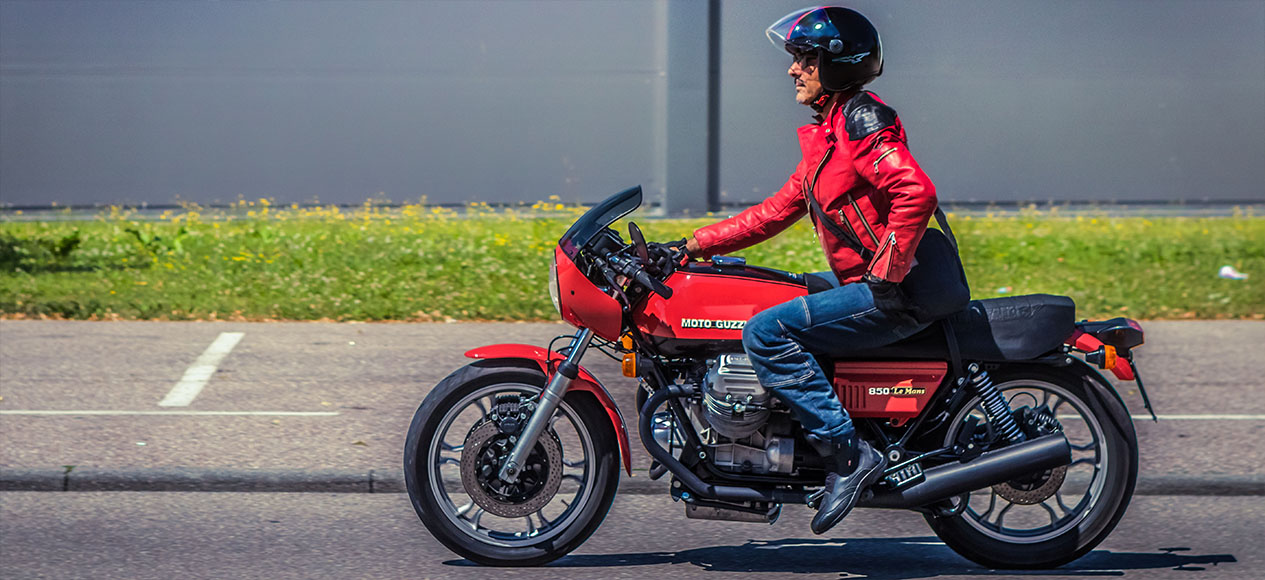Italian bikes of the 1970s have a certain character about them. Whether it’s a V-twin Ducati, Laverda triple or a multi-cylinder Benelli, the Italian bike industry came up with a diverse range of superbikes that offered a genuine alternative to the then new generation of Japanese 750s and classic British twins.
Arguably the most beautiful of the Italian stallions came from Moto Guzzi, and the Le Mans café racer, which was launched in 1976 and is now a bona fide classic motorbike.
Tracing its roots back to 1967 and the 750cc V7, the Le Mans took Guzzi’s unique, transversely mounted 90-degree V-twin motor and punched it out to 844cc, lifting power from 53bhp to 71bhp in the process. That gave it performance that was more than a match for the contemporary Triumph Bonneville and Honda CB750, with a claimed top speed in excess of 130mph.
And while the Le Mans, named after the famous French 24 hour endurance race venue, had the performance, it was the looks that really grabbed the public’s attention. In days when motorcycle ergonomics were much of a muchness between the various manufacturers and models, Moto Guzzi fitted their new sportster with low clip-on handlebars and a bikini fairing. While fairings had been a standard fitment to racing bikes for decades, the Guzzi was one of the first road bikes to feature aerodynamic bodywork, following in the tyre tracks of BMW’s R90S from 1973.
With its long wheelbase, 200kg dry weight and shaft final drive, the Le Mans lacked the pure sporting abilities of the Japanese machines but it was still a spirited performer that went around the corners well enough. With big valves, high compression pistons, twin exhaust pipes and 36mm Dell’Orto carbs with velocity stacks, the Guzzi had a rorty feel to it, while that unique engine layout gives it a characteristic not dissimilar to a BMW boxer. The five speed gearbox, however, was somewhat agricultural, even by standards of the time. Handling and braking, while feeble by today’s standards, were up to the job in the 1970s and Moto Guzzi had some moderate race track success in the few endurance races and national championships they entered.
In total around 6000 of the original (later known as Mark One or MkI) Le Mans were made between 1976 and 1978. After the initial run of 2000 units, some detail changes were brought in for the Series Two version. This version (pictured) can be identified by the rectangular (rather than round) tail light and a bigger seat unit.
In 1979, the Le Mans evolved into the Mark Two (MkII) version. It remained a fine motorcycle, even if it lacked the purity of the original. The wind tunnel developed fairing was larger and featured a rectangular fairing rather than a round one, while the new forks were air assisted. The instrument cluster was new, and the brakes were linked for the first time. The Le Mans III arrived in 1981 and had 44 further changes, including a more angular and contemporary restyle. This version arrived lasted a further two years, before the capacity was increased to 949cc for the renamed Le Mans 1000. The Le Mans nameplate continued until 1993, although the later 1000s lacked the wow factor of the originals and fell behind the competition on pretty much all fronts.
Sound 850s are relatively easy to pick up these days and fetch good, but not crazy, money on the classic bike scene. Electrical issues with 1970s Italian bikes are well documented, as were the rust problems and a general level of slackness in build quality, but four decades on pretty much all bikes on the market will have been restored to some degree or another by now.
At £2000 when launched, the Guzzi was almost twice the price of a Triumph Bonneville T140, but these days a usable early Le Mans comes in at around £5000 – similar to other 1970s classics.
Find a good one, cherish it and enjoy, because the Moto Guzzi Le Mans is most certainly an iconic motorcycle.




